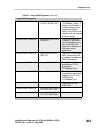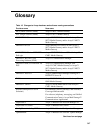
Glossary:
Installation and Upgrades for G700 with S8300 or S8700
555-234-100 — Issue 3 — May 2003
311
Administration Without Hardware (AWOH)
A feature that is used to administer ports without the need for associated terminals or other hardware.
ADU
See
asynchronous data unit (ADU).
Advanced Private-Line Termination (APLT)
Term that denotes that a user has access to all the services of an associated Enhanced Private Switched Communications
Network (EPSCN) or an associated Common Control Switching Arrangement (CCSA) network. See also Enhanced
Private Switched Communications Service (EPSCS); Communications Controller (CC).
AE
See
access endpoint.
AEC
See acoustic echo cancellation (AEC)
.
after-call work (ACW) mode
One of four agent work modes. In ACW mode, agents are unavailable to receive ACD calls. Agents enter the ACW mode
to complete forms or perform other activities that are related to a previous ACD call. See also auto-in work mode
; aux
work mode; manual-in work mode.
AG
ASAI Gateway
agent
A person or a device that receives calls that are directed to an ACD hunt group or an ACD split. Also called an ACD
agent.
agent report
A report that provides historical traffic information for internally measured agents.
AIM
Asynchronous interface module
AIOD
Automatic Identification of Outward Dialing
AIS
See alarm indication signal (AIS)
.
alarm
An system-generated indication that a fault is present. See also ALM, ALRM
; major alarm; minor alarm.
alarm indication signal (AIS)
An SA signal that is inserted when a network element receives a faulty signal. The AIS is then forwarded downstream to
tell the receivers what happened.
ALBO
Automatic line buildout
all trunks busy (ATB)
The state in which no trunks are available to handle calls.
ALM, ALRM
Alarm
ALM-ACK
Alarm acknowledge


















